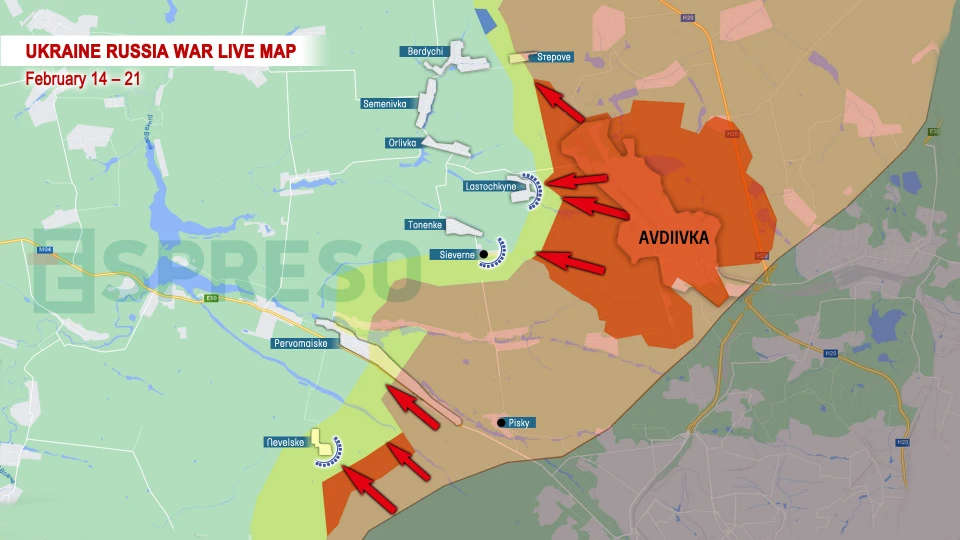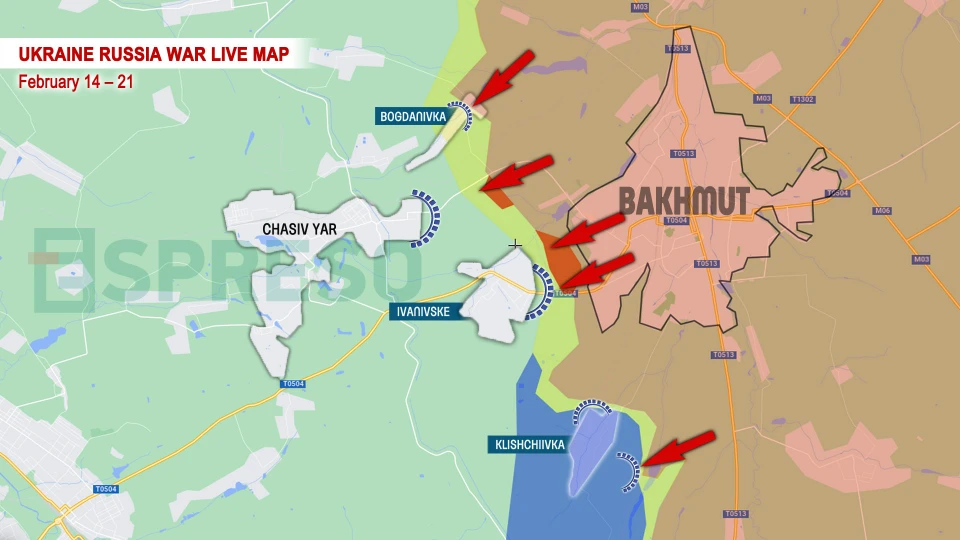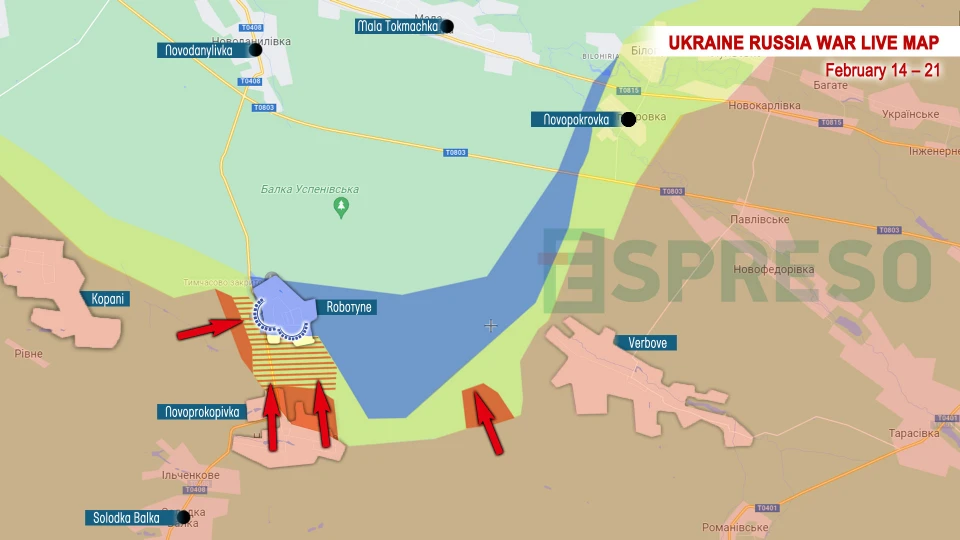
Ukrainian defense line in Avdiivka direction may move westward over time. Column by Serhiy Zgurets
Russia is trying to take advantage of its superiority in manpower and equipment while there is still a window of opportunity, conducting attacks in several directions
The situation on the front line
Ukraine’s Defense Forces are really on the defensive. Russia is putting pressure and conducting attacks on several fronts trying to use its advantage in manpower, artillery ammunition and aviation, which is now actively using guided bombs in all parts of the frontline. On February 25, 95 combat clashes took place, which is actually a lot. The situation is the hottest in the Marinka direction, where 40 Russian attacks took place and were repelled. Despite all this tension, there are no changes on the map.
But as for the changes, we have to take into account the fighting near Avdiivka along the Stepove-Orlivka-Ivanivske-Sieverne-Pervomayske line. Ukrainian brigades, which had previously held the defense of Avdiivka, moved to this line and held it quite courageously. On February 26, Dmytro Lykhoviy, spokesman for the Tavria group of troops, officially said that the Ukrainian Armed Forces withdrew from the village of Lastochkyne, located 6 km from Avdiivka. According to him, such a maneuver was necessary to organize defense along the Berdychi-Orlivka-Tonenke line and prevent Russian troops from advancing further west.

The withdrawal of our troops took place a day earlier. The withdrawal of our troops from Lastochkyne is a fully justified step in the current conditions on the front line. This is because Russian troops continue to attack in other directions in this area.
Attacks continue in the direction of Orlivka, Sieverne and Stepove. The fighting is taking place close to these settlements. Russia is also trying to put pressure near Stepove. Abrams tanks of the 47th separate mechanized brigade are actively used in this area. Ukraine’s 47th Brigade's potential is extremely high, given its experience in combat operations in the south, and now in holding positions near Stepove. But Russian troops are still advancing in some areas.
To the east of Orlivka (a settlement not far from Lastochkyne), Russian troops have advanced to a depth of about 400 meters. Fighting is also ongoing near the village of Tonenke, and we can assume that in some time our defense line may move a little to the west. There are different estimates of where exactly Russian troops will be stopped because there are different defense lines. In particular, one of the most remote lines, which was built in 2015, runs along a line of heights and water obstacles. But it is too early to talk about retreating to it. The issue is that the Ukrainian military, who hold the line of the current positions, say that there are many complaints about the fortifications built along the line of the villages where our defenders are currently holding the line.
As for other directions, Russia is trying to actively push toward Chasiv Yar, conducting attacks from several vectors. Near Bohdanivka, fighting continues near the railway station. From the north and east, Russian troops are trying to push towards Ivanivske, around which fighting continued for almost the entire day.

Russia’s combat actions resemble the tactics of frenzied infantry. Russian forces are also using chemical munitions. Currently, two Ukrainian brigades are working near Ivanivske: the 5th Assault Brigade is on one side and the 17th Tank Brigade is on the left. The interaction of these two brigades significantly affects the effectiveness of deterring the enemy. We have ammunition in this area. I hope that Russian troops will be eliminated and will not advance into Ivanivske itself.

The tactics of frenzied infantry are also noticeable in other parts of the frontline. In particular, if we mention Robotyne, we have a 10-by-10-kilometer gap in Russia’s defense there.
It is now amassing forces there again to try to push the Ukrainian military out of this area, which is more of a political task, just like the situation with the capture of Avdiivka. We understand that the situation in all parts of the frontline is difficult. I hope that foreign aid will continue to come in larger volumes in the near future.
Development of the Ukrainian defense industry
Pavlo Kyshkar, Deputy Commander of the Artillery Division, Major, Head of the Project Office of the Ministry of Defense Accelerator, former Member of Parliament, noted that today any emphasis in Ukraine's life will begin with the word "war." However, war is also a chance for the development of the defense industry. In the context of mobilization, we often repeat that we need technical mobilization, i.e. mobilization of the Ukrainian defense industry, which would allow us to effectively perform tasks on the battlefield to protect the territorial integrity of Ukraine. These interrelated things will determine our next year or two. And after the war, with the development of the defense industry, we will be able to take advantage of this economic and technological advantage in selling our defense industry achievements, selling military and dual-use goods. This technological advantage should be provided by the Ukrainian defense industry. Politicians often talk about this, but nothing changes at the front. We will expect both human resources and technological solutions, and most importantly, production scaling.
The head of the Ministry of Defense Accelerator's project office added that the situation with electronic warfare and electronic warfare systems is critical today, and it is also interesting to scale up production so that these are solutions that would stand on production lines and allow us to cover a wide range from Russian aircraft.
On the mobilization process
The major noted that we never told Ukrainian society that we were building our army on different principles than the Soviet ones. Unfortunately, this did not happen. We are calling people back to the Soviet system. For example, Pavlo Kyshkar invited a person who had health restrictions to join the military, but people who would not be responsible for this person in combat in any way deprived him of the opportunity to involve him in his unit.
And this should not be the case, because Kyshkar, as a unit commander, is responsible for people, not a recruitment center employee or the head of a training center. Granting unit commanders the freedom to form units would enhance accountability, as they would be directly responsible for the individuals under their command, fostering stronger connections between soldiers and their leaders. Soldiers would willingly gravitate toward commanders they trust and are familiar with. And now we are calling into the unknown, into the scoop, where nothing depends on the individual, so the principles of army formation should be voluntary.
- News












































